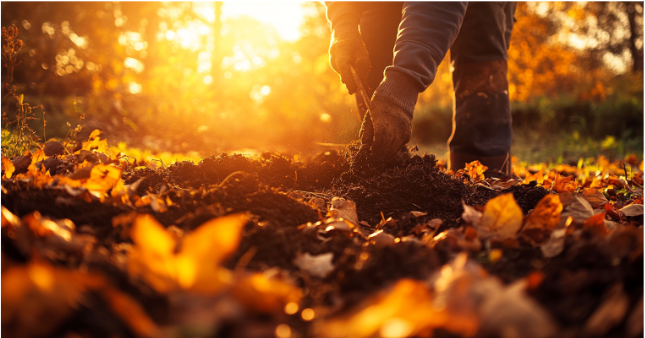As the growing season winds down, autumn presents a perfect opportunity to lay the groundwork for a thriving spring garden. Investing time in soil preparation will give your plants the best chance to flourish when warmer weather returns. By enriching the soil and promoting healthy plant growth you can set the stage for a bountiful garden. This guide walks you through the essential tasks to prepare your garden beds for a vibrant spring season.
A gardener working in an autumn garden, rich soil being tilled, the golden glow of the autumn sun filtering through the trees. Compost and organic matter being mixed into the soil, fallen leaves scattered around. Soft light, peaceful countryside, preparing for a bountiful spring garden.
Why Autumn Soil Preparation Is A Must
Plants deplete nutrients from the soil throughout the growing season. By the time autumn arrives, your garden beds will need replenishment. Autumn preparation restores these nutrients and improves soil structure. It readies your garden for the next season. Performing this activity during fall allows your soil enough time to recover before spring planting. Learn more about nutrient depletion from the Royal Horticultural Society.
Steps for Preparing Your Garden Soil
You’ll need to complete several important tasks during autumn to ensure your soil is rich in nutrients, well-aerated, and ready to support new plant life come springtime. From testing your soil’s pH to adding organic matter mulch, each task plays a vital role in creating healthy, fertile soil. Let’s take a closer look at the steps needed:
Soil Testing
Always start with a soil test before making any changes. Soil testing reveals your soil’s pH, nutrient levels, and texture, all of which indicate your soil’s health and nutrient levels. Once you know your garden’s exact state, you are better prepared to make informed decisions on how to improve soil conditions. Read more about soil testing from the University of Minnesota Extension.
Clearing and Tilling the Soil
Clear your garden beds of plant debris and weeds. This step prevents pests and diseases from being carried over to the next season. Afterward, till the soil to a depth of 8 to 12 inches. Tilling aerates the soil, breaks up compacted areas, and prepares it to receive organic matter.
Adding Organic Matter
Adding organic matter is vital for soil health as it replenishes lost nutrients. Compost, aged manure, and leaf mold enrich the soil and improve its structure. Spread a 2 to 3-inch layer of organic matter over the tilled soil and mix it in thoroughly. Doing so makes nutrients readily available to help with spring growth.
Learn more about composting from the U.S. Environmental Protection Agency (EPA).
Using Cover Crops for Natural Fertilization
Consider planting cover crops like clover or rye to protect and nourish the soil. These crops prevent erosion, suppress weeds, and enhance soil structure. As they grow, they also contribute to improving the soil’s condition. Once spring arrives, till the crops into the soil for added organic matter. Discover how cover crops improve soil health from the USDA.
Mulching
Mulching in the fall is also essential for long-term soil health. Apply a thick layer of mulch to protect your garden beds from erosion, retain moisture, and regulate soil temperature. As the mulch breaks down, it enriches the soil and prepares it for the next planting season.
Adjusting Soil pH for Optimal Growth
The pH of your soil directly impacts how well plants can absorb nutrients. Most plants prefer a pH between 6.0 and 7.0. Use your soil test results to adjust the pH levels. If your soil is too acidic, adding lime will raise the pH levels. If it’s too alkaline, adding peat moss or sulfur will lower the values.
Fertilizing the Soil
Autumn is the perfect time to apply slow-release fertilizers. Organic fertilizers like bone meal, rock phosphate, and greensand provide the needed nutrients that gradually seep into the solid over the winter. By the time spring arrives, your soil becomes more enriched.
Reap the Benefits of Autumn Soil Preparation
Preparing your soil in the fall ensures a fertile and workable soil when the next planting season arrives. Moreover, you’ll save time during the spring since much of the groundwork will be done. A well-prepared garden bed leads to healthier plants and a more productive garden.
Autumn soil preparation also helps reduce the risk of pests and diseases that might otherwise linger into the next season. By clearing debris and adding protective layers such as mulch, you create a healthier environment for your plants. Meanwhile, the nutrients you added during the fall will have more time to break down. These efforts translate into stronger plants, better blooms, and a more manageable gardening experience.
Create Your Dream Garden with Fall Preparations
Fall soil preparation is not just an autumn chore—it’s the key to a thriving garden the following year. Doing so sets up your garden for success. Testing the soil, adding organic matter, planting cover crops, mulching, adjusting pH, and fertilizing will all contribute to healthier plants during the spring. Don’t wait—start now and prepare for a garden that will flourish as soon as spring begins!
Explore our garden care tips for more ways to ensure a successful growing season.



